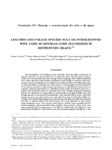Use este identificador para citar ou linkar para este item:
http://www.alice.cnptia.embrapa.br/alice/handle/doc/970805Registro completo de metadados
| Campo DC | Valor | Idioma |
|---|---|---|
| dc.contributor.author | CECCON, G. | pt_BR |
| dc.contributor.author | STAUT, L. A. | pt_BR |
| dc.contributor.author | SAGRILO, E. | pt_BR |
| dc.contributor.author | MACHADO, L. A. Z. | pt_BR |
| dc.contributor.author | NUNES, D. P. | pt_BR |
| dc.contributor.author | ALVES, V. B. | pt_BR |
| dc.date.accessioned | 2013-11-08T11:11:11Z | pt_BR |
| dc.date.available | 2013-11-08T11:11:11Z | pt_BR |
| dc.date.created | 2013-11-08 | pt_BR |
| dc.date.issued | 2013 | pt_BR |
| dc.identifier.citation | Revista Brasileira de Ciência do Solo, Viçosa, MG, v. 37, n. 1, 204-212, Jan./Feb. 2013. | pt_BR |
| dc.identifier.issn | 0100-0683 | pt_BR |
| dc.identifier.uri | http://www.alice.cnptia.embrapa.br/alice/handle/doc/970805 | pt_BR |
| dc.description | The feasibility of no-tillage in the Cerrado (Savanna-like vegetation of Brazil) depends on the production of sufficient above-ground crop residue, which can be increased by corn-forage intercropping. This study evaluated how above-ground crop residue production and yields of soybean and lateseason corn in a soybean-corn rotation were influenced by the following crops in the year before soybean: corn (Zea mays L.) intercropped with Brachiaria (Urochloa) brizantha cv. Marandu, B. decumbens cv. Basilisk, B. ruziziensis, cv. comum., Panicum maximum cv. Tanzânia, sunn hemp (Crotalaria juncea L.), pigeon pea [Cajanus cajan (L.) Millsp]; sole corn, forage sorghum [Sorghum bicolor (L.) Moench (cv. Santa Elisa)], and ruzi grass. In March 2005, corn and forage species were planted in alternate rows spaced 0.90 m apart, and sole forage species were planted in rows spaced 0.45 m apart. In October 2005, the forages were killed with glyphosate and soybean was planted. After the soybean harvest in March 2006, sole late-season corn was planted in the entire experimental area. Corn grain and stover yields were unaffected by intercropping. Above-ground crop residue was greater when corn was intercropped with Tanzania grass (10.7 Mg ha-1), Marandu (10.1 Mg ha-1), and Ruzi Grass (9.8 Mg ha-1) than when corn was not intercropped (4.0 Mg ha-1). The intercropped treatments increased the percentage of soil surface covered with crop residue. Soybean and corn grain yields were higher after sole ruzi grass and intercropped ruzi grass than after other crops. The intercropping corn with Brachiaria spp. and corn with Panicum spp. increases above-ground crop residue production and maintains nutrients in the soil without reducing late-season corn yield and the viability of no-till in the midwestern region of Brazil. | pt_BR |
| dc.language.iso | eng | eng |
| dc.rights | openAccess | eng |
| dc.subject | No-till | pt_BR |
| dc.subject | Above-ground crop residue | pt_BR |
| dc.title | Legumes and forage species sole or intercropped with corn in soybean-corn succession in midwestern Brazil. | pt_BR |
| dc.type | Artigo de periódico | pt_BR |
| dc.date.updated | 2014-06-18T11:11:11Z | pt_BR |
| dc.subject.thesagro | Biomassa | pt_BR |
| dc.subject.thesagro | Cerrado | pt_BR |
| dc.subject.thesagro | Cobertura do solo | pt_BR |
| dc.subject.thesagro | Plantio direto | pt_BR |
| dc.subject.nalthesaurus | biomass | pt_BR |
| riaa.ainfo.id | 970805 | pt_BR |
| riaa.ainfo.lastupdate | 2014-06-18 | pt_BR |
| dc.identifier.doi | http://dx.doi.org/10.1590/S0100-06832013000100021 | pt_BR |
| dc.contributor.institution | GESSI CECCON, CPAO; LUIZ ALBERTO STAUT, CPAO; LUIS ARMANDO ZAGO MACHADO, CPAO. | pt_BR |
| Aparece nas coleções: | Artigo em periódico indexado (CPAO)  | |
Arquivos associados a este item:
| Arquivo | Descrição | Tamanho | Formato | |
|---|---|---|---|---|
| CECCON.pdf | 76,4 kB | Adobe PDF |  Visualizar/Abrir |









